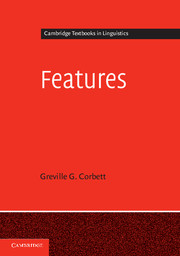Book contents
- Frontmatter
- Contents
- Figures
- Tables
- Preface
- Abbreviations
- 1 Why features?
- 2 Formal perspectives
- 3 Features for different components
- 4 Justifying particular features and their values
- 5 Typology
- 6 Canonical Typology and features
- 7 Determining feature values
- 8 Feature-value mismatches
- 9 Conclusions
- Appendix Standards and implementations
- References
- Author index
- Language index
- Subject index
1 - Why features?
Published online by Cambridge University Press: 05 November 2012
- Frontmatter
- Contents
- Figures
- Tables
- Preface
- Abbreviations
- 1 Why features?
- 2 Formal perspectives
- 3 Features for different components
- 4 Justifying particular features and their values
- 5 Typology
- 6 Canonical Typology and features
- 7 Determining feature values
- 8 Feature-value mismatches
- 9 Conclusions
- Appendix Standards and implementations
- References
- Author index
- Language index
- Subject index
Summary
Language has such a central place in our lives and in research that it is difficult to find an outside vantage point from which to achieve real understanding. As linguists, we attempt to do this by treating language as our object, while restricting the use of language as the tool. As a result of this approach, linguistics is in an exciting phase. Theories compete for overlapping segments of the research space. There is a sense of great achievement in some areas and equally of uncertainty about common goals. In this rapidly changing scene, one constant is the use of features. Fieldworkers, sociolinguists, computational linguists, syntacticians, working on spoken or on signed languages, all standardly use features. They are the key underpinning for linguistic description. We use features a good deal, but sometimes we take them for granted, assuming we all share the same conventions. In reality, the use of superficially similar notations sometimes hides differences in the underlying logic as well as in the substantive semantics of features.
It is therefore worth working through the motivation for using features, and the choices available to us. Naturally, different researchers make different choices; the important thing is that these should be reasoned choices, and that they should be made explicit. We shall give special attention to syntax and morphology, since it is in these components that the use of features requires the clearest argumentation. This is because these features do not have direct correspondences in meaning or sound, we have not such immediate evidence for them, and hence must justify their use with particular care. Having isolated the distinctions which we model using features, it is natural to typologize across them. As with all typology, we need to consider carefully whether we are comparing like with like, an issue which we discuss in §5.1.
- Type
- Chapter
- Information
- Features , pp. 1 - 14Publisher: Cambridge University PressPrint publication year: 2012



